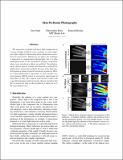Skin perfusion photography
Author(s)
Satat, Guy; Barsi, Christopher; Raskar, Ramesh
DownloadRaskar_SkinPerfusionPhotography.pdf (2.804Mb)
OPEN_ACCESS_POLICY
Open Access Policy
Creative Commons Attribution-Noncommercial-Share Alike
Terms of use
Metadata
Show full item recordAbstract
The separation of global and direct light components of a scene is highly useful for scene analysis, as each component offers different information about illumination-scene-detector interactions. Relying on ray optics, the technique is important in computational photography, but it is often under appreciated in the biomedical imaging community, where wave interference effects are utilized. Nevertheless, such coherent optical systems lend themselves naturally to global-direct separation methods because of the high spatial frequency nature of speckle interference patterns. Here, we extend global-direct separation to laser speckle contrast imaging (LSCI) system to reconstruct speed maps of blood flow in skin. We compare experimental results with a speckle formation model of moving objects and show that the reconstructed map of skin perfusion is improved over the conventional case.
Date issued
2014-05Department
Massachusetts Institute of Technology. Media Laboratory; Program in Media Arts and Sciences (Massachusetts Institute of Technology)Journal
2014 IEEE International Conference on Computational Photography (ICCP)
Publisher
Institute of Electrical and Electronics Engineers (IEEE)
Citation
Satat, Guy, Christopher Barsi, and Ramesh Raskar. “Skin Perfusion Photography.” 2014 IEEE International Conference on Computational Photography (ICCP) (May 2014), Santa Clara, Calif. p.1-8.
Version: Author's final manuscript
Other identifiers
INSPEC Accession Number: 14383054
ISBN
978-1-4799-5188-8